Water storage is a very important part of emergency preparedness. An individual can survive without food for a few weeks, but without water they would only survive a few days. So, an extra supply of water is a MUST for emergency survival and preparedness.
The recommended amount of water to store for one person is at least one gallon per day for a minimum 3 day supply and, if possible, store enough for 2 weeks (https://www.cdc.gov/healthywater/emergency/creating-storing-emergency-water-supply.html). If you live in a hot climate, are pregnant or are sick, you should try to store more than the recommended 1 gallon per day.
There are several ways to store water. You can purchase bottled water (watch expiration dates) or use other storage containers and fill them with water. If the containers are used, make sure they did not contain bleach or other toxic substances. Only store water in food safe containers and if they previously held other food or liquid items, be aware that the flavor from those items may affect the taste of your water as the pores in the plastic may have absorbed some of the original contents. Avoid using containers that will decompose or break such as milk cartons or glass jars. If you prefer to use smaller containers, ones that have held juice or the 2-liter bottles of soda work well for water storage. Larger containers, such as 5-gallon, 15-gallon or 55-gallon water drums, can be purchased through emergency preparedness and food storage web sites or at some local hardware stores – just make sure they are food grade plastic.
Stored water that is not store-bought should be rotated about every 6 months and should be purified before drinking. Water purification can be done either when you are ready to use it or you can purify it when you are filling the containers for storage. There are 3 main methods of water treatment. There are water filtration kits to filter the water for drinking and is considered to be the easiest and safest way to treat water. The micron size for the water filter should be at least 0.4 microns or less for removing bacteria. Larger protozoa or parasites can be removed with nearly any size filter as they are much larger than bacteria. Chemicals are usually preferred when storing large amounts of water. Some of these options are chlorine bleach (label must say it contains between 5% and 9% of sodium hypochlorite to disinfect water), aerobic stabilized oxygen and iodine based purification tablets or solutions. Boiling water is also a good way to purify the water, although this option requires fuel and/or electricity to heat the water and the water may taste flat.
Since water storage is such an important part of being prepared, it is a good idea to research to determine the best way to store and purify water for your personal situations. These websites have good information on emergency preparedness that will help you get ready for the types of emergency situations you may face:
https://www.cdc.gov/healthywater/emergency/creating-storing-emergency-water-supply.html
Local agencies or community centers can also be a good resource for emergency planning for your particular location. Learning what you need to store and how to store it can help you on your path to being ready for any type of emergency situation and the peace of mind that comes with being prepared.


